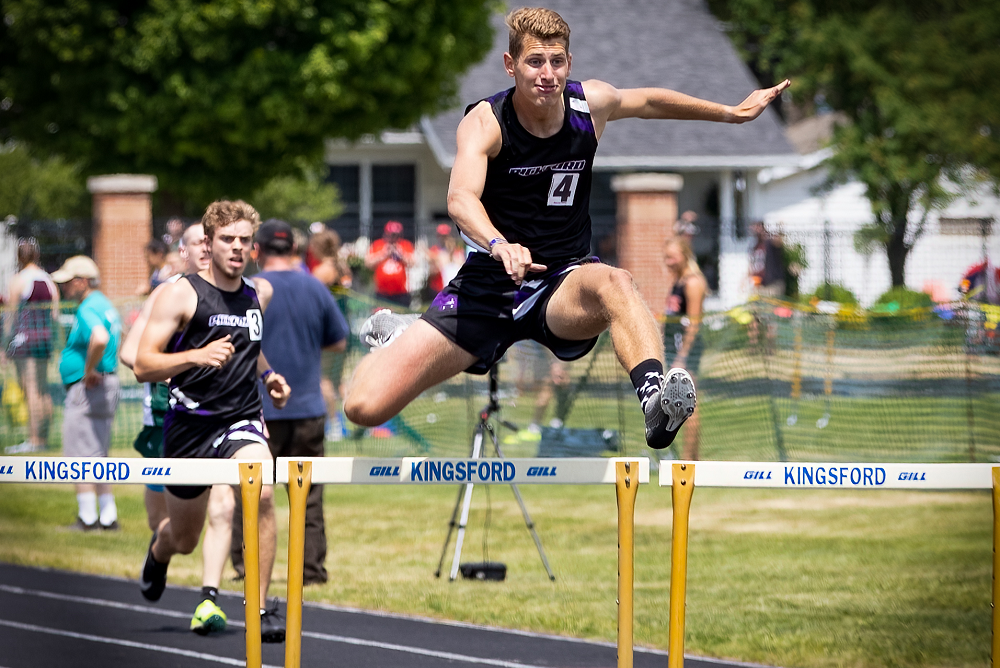
Performance of the Week: Pickford's David Kozisek
June 9, 2023
 David Kozisek ♦ Pickford
David Kozisek ♦ Pickford
Senior ♦ Track & Field
Kozisek was an exchange student from Czech Republic this school year, and when he returns home this week he'll do so having accomplished a rare feat in MHSAA track & field history. On Saturday he became the ninth male athlete to win four individual events at a Finals, taking first in the 110 hurdles (15.40), 300 hurdles (41.39), high jump (6-3) and long jump (20-10) in helping Pickford to the Upper Peninsula Division 2 team championship.
After also playing football and basketball for the Panthers, Kozisek joined the track & field team this spring with plenty of knowledge having competed in that sport over the last six years in his home country. He was incredibly close to leaving an even larger historical imprint last weekend; Kozisek's long jump and high jump both were just one inch off tying UPD2 Finals records, and his 110 time missed that meet record by only six hundredths of a second. He was the first to win four boys events with the combination of two hurdles races and two jumps, and the second four-time individual winner joining Joe Baker, who in 1974 became the first from any school to win four Finals events.
Follow the MHSAA on TikTok.
MHSAA.com's "Performance of the Week" features are powered by MI Student Aid, a part of the Office of Postsecondary Financial Planning located within the Michigan Department of Treasury. MI Student Aid encourages students to pursue postsecondary education by providing access to student financial resources and information. MI Student Aid administers the state’s 529 college savings programs (MET/MESP), as well as scholarship and grant programs that help make college Accessible, Affordable and Attainable for you. Connect with MI Student Aid at www.michigan.gov/mistudentaid and find more information on Facebook and Twitter @mistudentaid.
2022-23 Honorees
June 1: Helena McLellan, Northville soccer - Report
May 25: Mitchel Luck, Linden lacrosse - Report
May 18: Ahava Le Febre, Holland tennis - Report
May 11: Gracie Maloney, Macomb Dakota softball - Report
May 4: Braxton Brann, Ann Arbor Huron track & field - Report
April 27: Owen Patton, Vestaburg track & field - Report
April 20: Lilly Damm, Millington softball - Report
April 13: Larissa Huffman, Mackinaw City track & field - Report
April 6: Darius Acuff, Detroit Cass Tech basketball - Report
March 23: Regan Finkbeiner, Hemlock basketball - Report
March 16: Alaina Yaney, Grand Ledge gymnastics - Report
March 9: Braeden Davis, Dundee wrestling - Report
March 2: Gabriel Sanchez-Burks, Ann Arbor Pioneer swimming - Report
Feb. 23: Grace Sobczak, Marquette swimming - Report
Feb. 16: Kaitlynn Demers, Gibraltar Carlson competitive cheer - Report
Feb. 9: Indya Davis, West Bloomfield basketball - Report
Feb. 2: Braydon Sorenson, Onekama skiing - Report
Jan. 26: Shayna Hruska, Iron Mountain wrestling - Report
Jan. 19: Kayla Tafanelli, Warren Woods-Tower bowling - Report
Dec. 20: Brenden Paden, Riverview Gabriel Richard hockey - Report
Dec. 16: Tuff Scott, Holton bowling - Report
Dec. 9: Macey Fegan, Standish-Sterling basketball - Report
Dec. 2: Treyton Siegert, Gladwin football - Report
Nov. 24: Lily Witte, Dexter diving - Report
Nov. 17: Navea Gauthier, Shelby volleyball - Report
Nov. 10: Derek Huisman, Holland Christian soccer - Report
Nov. 3: Thomas Westphal, New Baltimore Anchor Bay cross country - Report
Oct. 27: Justin Wickey, Colon football - Report
Oct. 20: Owen DeMuth, Bloomfield Hills Cranbrook Kingswood tennis - Report
Oct. 13: Mia Melendez, Ann Arbor Greenhills golf - Report
Oct. 6: Shawn Foster, Grand Ledge football - Report
Sept. 30: Hannah Smith, Temperance Bedford swimming - Report
Sept. 22: Helen Sachs, Holland West Ottawa cross country - Report
Sept. 15: Nina Horning, Lake Orion volleyball - Report
Sept 8: Arturo Romero, Muskegon Oakridge soccer - Report
Sept. 1: Austin King, Midland Dow tennis - Report
Aug. 25: Olivia Hemmila, Troy Athens golf - Report
PHOTOS courtesy of 2BU Photography.

Track Gaining Speed Toward Future with Electronic Starting Devices
By
Steve Vedder
Special for MHSAA.com
May 23, 2023
Aubrey Greenfield thinks it might be the perfect time to reevaluate 130 years of tradition.
For a number of reasons, from technical to personal, the Oxford senior sprinter believes it makes sense for the crack of a starting pistol to be eliminated from high school track meets.
Because track meets would benefit in various ways from lowering costs to easier setup at meets to the human factor of competitors not having to flinch at the crack of a pistol shot, Greenfield believes the sport has a chance to embrace new technology – electronic starting devices (ESD).
In essence, an ESD replaces the starting pistol with a light flash, tone sound or both to begin a race.
"High school sports should put the athlete first," Greenfield said. "We should promote sports, and eliminating starting pistols promotes health in terms of PTSD or trauma for athletes and spectators and that would be good. I would like to think people would say that's a good idea."
In fact, Greenfield would go as far as to say if there was not an implementation of electronic starting devices, many of her teammates would have considered giving up the sport.
"If it's something that helps us compete safely, we're all for it," she said.
Greenfield's opinion apparently is spreading. Michigan High School Athletic Association senior assistant director Cody Inglis said the use of ESD makes it both affordable for meet starters and sensible for athletes and fans to rethink the use of starting pistols. While the MHSAA is not mandating electronic starting devices, it does promote the use of what Inglis calls "emerging technology." He notes that ESD are becoming the norm for organizations such as USA Track & Field, the NCAA and an increasing number of high schools.
 "I think we have to embrace new technology, and we think this will be something that takes hold," Inglis said.
"I think we have to embrace new technology, and we think this will be something that takes hold," Inglis said.
A key part of embracing ESD is the human element. The tragic Oxford High School shooting Nov. 30, 2021, that took the lives of four students while injuring seven others should not be relived even for a fleeting instance at a high school sporting event. Oxford athletic director Tony DeMare said the school began using ESD at every meet, including the MHSAA Lower Peninsula Division 1 Finals last June. He said that decision was embraced by virtually all schools Oxford encountered.
"We were very convinced that the alternative (of ESD) would promote a healthy attitude," DeMare said. "We were overwhelmed with the positive response. If a school was on the fence about it or might not be for it, I think we've started to see the tide turn in favor of people willing to listen and learn about electronic starting devices."
Inglis said the MHSAA is acutely aware of what the crack of a starting pistol can mean to athletes and fans.
"It's unimaginable what Oxford went through, and this is a small way we can help," he said. "We look at a (starting pistol) and think, ‘Could we do something else?’ It's a way of helping to solve a problem."
Over the last several years, the MHSAA has embraced finding an alternative to starting pistols. Inglis noted the discussion started with the cost and diminishing availability of 32-caliber ammunition that meet starters use. A box of ammunition, if it can be found, is around $75 a box.
In addition to cost, there is potential damage from excessive exposure to 150-plus decibels of sound generated by the traditional 32-caliber blanks. Medical studies show damage to ears caused by decibel levels above 120 dB.
The tragedy at Oxford accelerated the conversation.
Inglis said the cost of ESD can be likened to a school sinking money into artificial surfaces at football fields. Yes, there is a great cost at first, but over time money is ultimately saved. An ESD system itself ranges between $200 and $500. Speakers also may need to be purchased, but with ESD starting events like the 800 and 1,600-meter relays positioned near the outside lanes 8, 7, 6 and 5 would result in improved hearing by athletes at the start of a race.
There is one challenge with ESD that track administrators are working to overcome – lighting conditions that lessen the ability to see the ESD’s LED light or strobe when the button is pressed by a starter to begin a race. But that vision difficulty resulting from clear blue skies and backgrounds of setting suns can be substantially improved by incorporating a black background with an ESD – something as simple as a starter holding up black cardboard behind the lighting mechanism at the start of an event.
Inglis said when all factors are considered, the use of ESD makes sense.
 "With the climate we live in nowadays, no lookalike guns is good," he said. "We're not mandating this. But people are saying this is affordable."
"With the climate we live in nowadays, no lookalike guns is good," he said. "We're not mandating this. But people are saying this is affordable."
While switching to ESD would break 130 years of tradition, the timing could be a step forward, said Jeff Hollobaugh, co-author of the book "The Fleet Feet of Spring: Michigan's High School State Championships in Track & Field." He said while no definitive answer is possible, it's likely starting pistols were used at the inaugural state meet at the Jackson Fairgounds in 1895. The meet, which included events like tossing a 16-pound shot put, bike races and a 100-meter sprint, was sponsored by the Michigan Interscholastic Athletic Association (a predecessor to the MHSAA) and comprised mostly of the state's larger schools.
Hollobaugh's sentiments echo what many involved in today's high school track & field believe in terms of making a transition from starting pistols to electronic starting devices.
"It's a change, not necessarily good or bad, just different," he said. "It's not a drastic change, but it will take some getting used to. But it is the future. In the end, we'll all be fine."
DeMare believes the future of high school track will definitely include ESD.
"Our desire is that the practicality and sensibility of this will overcome the alternative," he said. "I think we'll see the automation and electronics taking hold of certain elements in track, and people will embrace it."
PHOTOS (Top) Runners watch official Bertha Smiley as they prepare to begin a race during last season's Lower Peninsula Division 1 Finals at Rockford. (Middle) An electronic starting device provided by VS Athletics was used to start those races. (Below) Smiley sets to begin an event. (Photos provided by David Kuderka/VS Athletics.)

